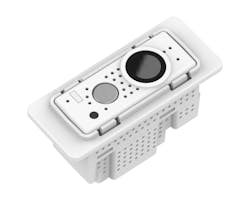Hubbell launches LED-luminaire-based video security IoT platform
Hubbell Lighting has introduced the SpectraSafe video security application intended for deployment on linear LED luminaires throughout a facility such as office space, retail, care facilities, banks, and more, and intended to supplant legacy video security systems. The building block of the solid-state lighting (SSL)-centric platform is a camera/sensor module intended for integration into luminaires. That module will communicate separately from other lighting-control networks using Wi-Fi to convey the high-definition video to cloud storage and enable viewing on mobile devices and PC clients. The intention is facility security based on Internet of Things (IoT) technology with guaranteed secure transmission and storage of the video data.
For the most part, the video security applications for connected SSL products that we have covered have been outdoors. For example, we published a feature article on the video system installed on street lights in San Diego, CA. That system shares a similar characteristic with the Hubbell SpectraSafe platform. In each case, a dedicated high-speed wireless link is used to transmit video independent of any other SSL connectivity scheme that may be in place.
We have written about security-oriented IoT applications indoors. But most of those applications have been based on occupancy sensors that can track people in a facility as opposed to cameras that can capture crimes or other questionable acts in vivid detail.
The camera module has an approximate 1×2-in. footprint and looks to be about 1.5 in. deep. Hubbell says the camera has a 144° FOV (field of view) although the Hubbell literature would suggest that the FOV is not symmetric. The module further integrates an infrared (IR) LED emitter to allow the camera to capture images in low/no light conditions along with an ambient light sensor to control the operation. The module further includes a microphone to capture audio and a speaker that would allow real-time, two-way communications with a person within the FOV.
A facility manager could utilize the video capabilities in a number of modes all supported by the Hubbell Camera Center applications that runs on mobile devices and PCs. Authorized users can monitor a camera in real time. There are ways to capture clips in cloud storage and an installation could automatically cache video for some amount of time based on resolution and elapsed time. The system supports time-lapse capture. And the system can autonomously react to motion/occupancy in a space and capture predetermined lengths of video footage. Hubbell will offer the Camera Center application on a subscription basis. For instance, you could choose to subscribe to a plan that included a month of cloud storage.
Hubbell said the video transmission to the cloud relies on transport layer security commonly used in Wi-Fi such as WPA-PSK along with encryption. The files stored in the cloud are encrypted using AES-256 technology. Subsequent transmission is made to an application client with Open TLS/SSL.
Initially, SpectraSafe will be available in Hubbell’s most popular recessed and surface-mount linear luminaires. Examples include Escalate, Revalume, LCAT, TCAT, Versify, and MultiPurpose Linear SSL product families.
Hubbell also has plans to offer third-party manufacturers the ability to integrate SpectraSafe in their own products. Indeed, Hubbell has long supplied third parties with its control and driver products through the Hubbell Control Solutions business unit. We’d presume that SpectraSafe would be sold through that channel as well, although Hubbell did not define its intended supply chain at launch.
It will be interesting to see going forward if the Wi-Fi network supported by SpectraSafe remains completely dedicated to the video application. It would not require much Wi-Fi bandwidth to handle other SSL control tasks. But for now, the SpectraSafe module has no way to communicate internally to an LED-based luminaire/LED driver.
For up-to-the-minute LED and SSL updates, why not follow us on Twitter? You’ll find curated content and commentary, as well as information on industry events, webcasts, and surveys on our LinkedIn Company Page and our Facebook page.

Maury Wright | Editor in Chief
Maury Wright is an electronics engineer turned technology journalist, who has focused specifically on the LED & Lighting industry for the past decade. Wright first wrote for LEDs Magazine as a contractor in 2010, and took over as Editor-in-Chief in 2012. He has broad experience in technology areas ranging from microprocessors to digital media to wireless networks that he gained over 30 years in the trade press. Wright has experience running global editorial operations, such as during his tenure as worldwide editorial director of EDN Magazine, and has been instrumental in launching publication websites going back to the earliest days of the Internet. Wright has won numerous industry awards, including multiple ASBPE national awards for B2B journalism excellence, and has received finalist recognition for LEDs Magazine in the FOLIO Eddie Awards. He received a BS in electrical engineering from Auburn University.





